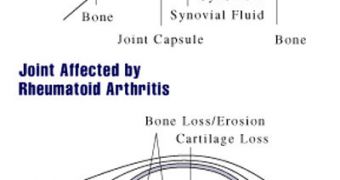Scientists in Europe are on the verge of a major breakthrough in the field of diagnostics. They have made significant strides in developing a new method for identifying which individuals with signs of joint pain and inflammation will go on to develop rheumatoid arthritis.
The condition is extremely painful and severe, and it incapacitates people nearly entirely in less than 10 years after its onset. In one third of all cases, those who develop it become disabled after only 5 years.
Seniors are affected most often, and the disease drastically contributes to a reduction in their overall well-being and quality of life. Figuring out ways of treating it is therefore essential on many levels.
Researchers from the University of Leeds, in the United Kingdom, say that they are nearing a “Holy Grail” detection method, that will allow them to pinpoint patients who are about to develop rheumatoid arthritis, but who are in the earliest stages of the disease.
Detecting these people in time is tremendously important, as their chances of getting cured increase considerably the earliest the disease is found. The most common symptoms include inflammation and pain in the joints, healthcare experts say.
An added advantage will be that people who only have mild forms of the condition will no longer be put on the same hard drugs as those with severe forms. This will allow doctors to treat the disease more unobtrusively.
The main goal in medical research today is to develop personalized medicine, a form of therapy that targets the needs of each individual patient. That is to say, each person is to receive drugs and treatment plans best suited for their needs.
Arthritis research UK professor of rheumatology Paul Emery, who is based at the Leeds University (LU) Leeds Institute for Molecular Medicine (LIMM), has been involved in this field for a decade.
Together with NIHR clinical lecturer in rheumatology Dr Jane Freeston, and a £300,000 grant from Arthritis Research UK, the professor is developing the new method of addressing rheumatoid arthritis detection. The disease currently affects about 380,000 people in the UK alone.
“Early aggressive treatment can stop this damage so we need to identify and reduce inflammation as early as possible, but currently we can't easily predict which patients with early signs of inflammation will go on to develop rheumatoid arthritis,” Dr Freeston says.
“With the potential consequences of over-treating patients at a stage where many patients are often unwilling to accept aggressive treatments, doctors are increasingly looking for accurate tools to predict how the disease will progress so treatment can be tailored to the needs of individual patients,” she says.
“That is what we hope to achieve,” the expert concludes.

 14 DAY TRIAL //
14 DAY TRIAL //